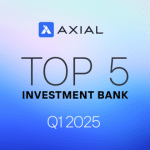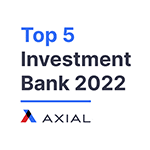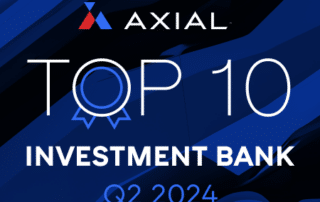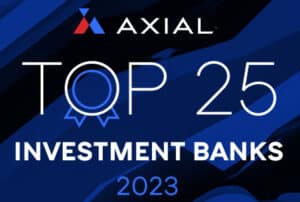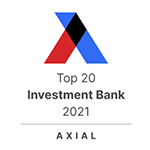Healthcare M&A Market Update
After a volatile two-year period, healthcare M&A activity in the United States has entered a phase of measured stabilization. Following a steep decline in transaction volume from the 2021 peak, 2025 has marked a turning point characterized by lower but steady deal flow, consistent valuations for high-quality assets, and renewed private equity confidence in the middle market.
While macro uncertainty, ranging from the One Big Beautiful Bill Act’s Medicaid provisions to ongoing reimbursement pressure, has kept investors cautious, healthcare’s defensive fundamentals continue to draw capital. Investors have increasingly focused on platform expansion, carve-outs, and specialty group consolidation as avenues for growth. As of Q3 2025, the market has shifted from triage to selective execution.
Private Equity Activity: Stabilized but Selective
According to PitchBook’s Q2 2025 Healthcare Services PE Update, dealmaking in the sector has “stabilized” after an early-year slowdown, with year-to-date volume keeping pace with 2024 levels. While the market remains below pre-2022 highs, it has avoided the severe contraction many anticipated.
Healthcare services transactions in 2025 are being shaped by several durable themes:
Selective Capital Deployment
Sponsors are focusing on proven platforms with strong compliance infrastructure, steady patient volumes, and reimbursement resilience.
Carve-Out Opportunities
Mid-market funds are capitalizing on carve-outs from corporates and payers seeking liquidity or refocus.
Operational Rigor
Portfolio add-ons now require clear post-close integration plans and measurable synergies.
Notably, transaction momentum has been sustained across home-based care, behavioral health, and dental segments, each showing renewed sponsor engagement after subdued 2023–2024 activity.
U.S. Healthcare Services PE Deal Volume (2020–2025)
| Year | Total Deals | Notable Trend | Commentary |
|---|---|---|---|
| 2020 | 720 | COVID disruption | Deferred elective care, but strong telehealth surge |
| 2021 | 940 | Peak cycle | Record valuations and liquidity-driven exits |
| 2022 | 820 | Initial correction | Interest rate hikes and valuation recalibration |
| 2023 | 690 | Bottoming cycle | Reduced sponsor-to-sponsor transactions |
| 2024 | 670 | Stabilization begins | Focused on add-ons and carve-outs |
| 2025 (est.) | 700–720 | Plateau in volume | Consistent with late-2020 levels; quality-driven processes |
*Source: Pitchbook
Market Bifurcation: Providers Outperform Payers
Public-market data from PitchBook’s Q3 2025 Healthcare Services Comp Sheet highlights a sharp bifurcation between payers and providers. As of September 2025, provider stocks were up roughly 14% year-to-date, while payer equities were flat amid rising utilization and margin compression. Medicaid-focused plans such as Centene and Molina reported year-to-date share declines of 41% and 34%, respectively, while facility operators like Tenet Healthcare and HCA Healthcare delivered double-digit gains supported by procedure growth and stable reimbursement trends.
This divergence underscores a broader reality: investors continue to favor patient-facing and ancillary service models with predictable utilization, particularly those with scale and vertical integration.
Subsector Valuation Trends
Despite higher financing costs, premium assets continue to command 10–14× EBITDA for platform-level transactions, with add-ons typically trading at 4–9×, depending on scale and ancillaries.
2025 U.S. Healthcare Services Valuation Ranges (EV/EBITDA)
| Specialty / Sector | Platform | Add-On | Typical Revenue Multiple | Key Value Drivers |
|---|---|---|---|---|
| Ophthalmology (incl. Retina) | 12×–20× | 5×–11× | ~1.0×–1.6× | ASC ownership, retina subspecialties, multi-location footprint |
| Dermatology | 12×–15× | 4×–9× | ~2.2×–3.5× | Cosmetic mix, Mohs surgery, medspa ancillaries |
| Cardiology | 12×–15× | 8×–12× | ~1.0×–1.6× | High procedural margins, limited supply of independents |
| Gastroenterology | 10×–14× | 7×–9× | ~0.9×–1.5× | Endoscopy centers, pathology, and anesthesia integration |
| Orthopedics / Sports Medicine | 9×–13× | 6×–9× | ~0.9×–1.5× | Imaging, ASC ownership, and physical therapy alignment |
| Women’s Health (OB/GYN) | 10×–14× | 5×–8× | ~0.9×–1.5× | Fertility, imaging, and menopause programs |
| Behavioral Health | 9×–13×+ | 3×–8× | ~0.8×–1.4× | Accreditation, multi-state models, in-network payer status |
| Primary Care / Multi-Specialty | 8×–12× | 3×–6× | ~0.8×–1.6× | Value-based care participation, ACO performance |
| Dental Support (DSO) | 9×–11× | 5×–8× | ~1.0×–1.8× | Specialization, hygiene programs, brand standardization, and regional density |
*Actual pricing varies with each transaction based on many factors. Intended for educational purposes only and not a guarantee of any outcome. Transactions are typically priced with an EBITDA multiple. Revenue multiples can vary widely (e.g., a transaction involving a highly efficient practice with an unusually high multiple of revenue).
Active Subsectors and Transaction Drivers
Behavioral Health
The behavioral health segment continues to attract investor attention. According to Scope Research, 2024 saw 160+ announced U.S. transactions, with average disclosed multiples ranging from 10–15× EBITDA for scaled autism and mental health platforms. Deals such as Tenex Capital’s acquisition of Behavioral Innovations (~15× EBITDA) illustrate strong demand for specialty models with proven outcomes data and payer diversification.
Dental and Specialty Physician Groups
Dental remains one of the most resilient verticals. Despite a modest pullback in sponsor-to-sponsor transactions, platform formation persists, supported by recurring revenue and predictable reimbursement. Orthopedics, cardiology, and ophthalmology groups remain among the most sought-after physician specialties, with platforms typically commanding double digit EBITDA multiples depending on ancillaries and subspecialty mix.
Home-Based and Post-Acute Care
Home-based care has reemerged as a preferred segment, with 33 PE deals completed year-to-date. We believe that reimbursement uncertainty has both slowed and accelerated deal volume as buyers and sellers navigate the market with varied approaches. Investors are drawn to hybrid service models that balance fee-for-service stability with value-based upside. Medicaid utilization pressures have moderated following the One Big Beautiful Bill Act, and continued demand for chronic care management supports long-term tailwinds.
Healthcare IT and RCM
Following 2024’s rebound, healthcare IT remains an active vertical, especially revenue cycle management (RCM), prior authorization, and analytics platforms. The TPG acquisition of Surescripts for ~$1.8 billion (~27× EBITDA) underscores the appetite for scaled, infrastructure-level assets with network density and recurring transaction revenue.
Buyer Landscape: Mid-Market Firms Regain Momentum
The U.S. healthcare buyout market continues to be dominated by mid-market private equity sponsors. Bain’s Global Healthcare Private Equity Report 2025 found that funds below $3 billion accounted for the majority of North American transactions in 2024 and 2025, a trend that has persisted into this year.
Key trends shaping this shift:
Operational Discipline
Smaller funds are leveraging deep operating partner networks and data-driven diligence to identify margin expansion opportunities.
Carve-Out Agility
Mid-market sponsors are executing carve-outs from corporates or larger funds seeking liquidity, often at favorable entry multiples.
Exit Planning
Average hold periods peaked in 2024 (6+ years) but are now compressing as limited partners push for realizations. Many healthcare services platforms will need to recap in the near future. We expect successful recaps to inject confidence and increase add-on deal volumes, especially recaps outside the PE universe.
Examples include recent middle-market deals in provider services, medtech components, and digital infrastructure, all driven by buy-and-build execution rather than single-asset scale bets.
Deal Structuring Trends
2025 transactions increasingly feature creative capital structures designed to align buyers and sellers while mitigating risk.
Common mechanisms include:
Earnouts and Performance Adjustments
Used to bridge valuation gaps created by 2022–2023’s interest rate shifts.
Roll-Over Equity
Founders often retain 20–30% ownership to benefit from future upside.
Minority Recapitalizations
A growing trend among specialty practices seeking liquidity without relinquishing full control.
According to the Bain Global Healthcare Private Equity Report, across transactions, the median debt-to-EBITDA ratio remains around 5.5×, roughly one turn lower than pre-2022 averages, reflecting lender conservatism and a renewed emphasis on cash flow quality over pure growth narratives.
Regulatory and Policy Landscape
Federal policy uncertainty continues to influence investment timing, but most sponsors now view regulatory headwinds as manageable. The July passage of the One Big Beautiful Bill Act initially caused concern about rising uninsured rates and Medicaid funding cuts. However, downstream effects have been less severe than expected, with most providers reporting stable patient volumes.
At the state level, new legislation such as Oregon’s SB 95 (mandating enhanced disclosure for PE-backed healthcare transactions) has drawn attention from other states considering similar frameworks. This shift toward state-level oversight has reinforced the importance of compliance readiness during diligence, particularly for multi-state operators.
Outlook: Entering a Period of Normalization
The healthcare M&A market is expected to close in 2025 on a stable footing. While volume will likely remain below the 2021 peak, conditions now favor disciplined investors and well-prepared sellers.
Several factors support a cautiously optimistic 2026 outlook:
Interest Rate Stability
The Federal Reserve’s commitment to maintaining a narrow range has improved underwriting confidence.
Bid-Ask Convergence
Multiples have plateaued, narrowing valuation spreads between buyers and sellers.
Liquidity Pressure
With portfolio hold periods peaking, sponsors are under increasing pressure to recycle capital through exits.
From a sector standpoint, the forecast shows continued strength in ophthalmology, behavioral health, and specialty primary care, with valuations for top-quartile assets remaining in the mid-teens EBITDA range. Conversely, payer and value-based models will likely see further bifurcation as reimbursement and utilization pressures persist.
Conclusion
Healthcare M&A in 2025 is best characterized by selective confidence. Investors have moved past the hesitation of 2023–2024 and are pursuing deals grounded in operational fundamentals, scale efficiency, and defensible reimbursement profiles. For physician groups and healthcare operators considering a transaction, this environment rewards preparation: clean financials, compliance readiness, and a well-articulated growth narrative remain essential to achieving premium outcomes.
If you are evaluating strategic options for your practice or healthcare business, the FOCUS team can help you understand how current market trends translate to valuation and deal readiness in your specific sector.
Learn More
FOCUS Investment Banking specializes in maximizing transaction value for healthcare practice owners through our proven quarterback approach to M&A advisory.
If you’d like to learn more about our healthcare investment banking services.
Sources:
PitchBook Q2 & Q3 2025 Healthcare Services Reports
Bain Global Healthcare Private Equity Report (2025)




